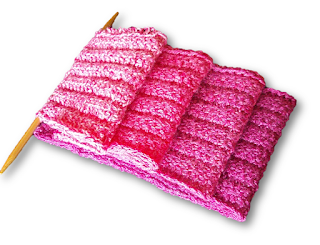My intent was to split time between finishing Herlacyn Breeze and knitting a few rows on my gradient scarf. Instead, I ditched discipline and wallowed in the pure pleasure of watching this simple but satisfying project grow.
When last you saw it, I was still working on the first section. Since then, I've managed to complete it plus two more sections and start the fourth.
I'm creating a five-stage gradient using only three yarn colors, a feat achieved by working the entire piece with two strands of lace weight carried throughout. The solid sections (one, three and five) feature two strands of the same color, while the marled sections (two and four) utilize one strand from each of the adjacent solid sections creating a blended transition that fades from one shade to the next. In other words:
At the most basic level, marled yarns have two different colored plies twisted together into a single strand. It's completely possible to emulate this at home, but I've decided instead to keep it simple, carry the two strands together, and let the marled effect evolve organically.
Normally, I'd opt for a more controlled approach, but for now, I've decided to relax and enjoy this adhoc adventure, marling and me.
Connecting with the linkups in the sidebar.
When last you saw it, I was still working on the first section. Since then, I've managed to complete it plus two more sections and start the fourth.
I'm creating a five-stage gradient using only three yarn colors, a feat achieved by working the entire piece with two strands of lace weight carried throughout. The solid sections (one, three and five) feature two strands of the same color, while the marled sections (two and four) utilize one strand from each of the adjacent solid sections creating a blended transition that fades from one shade to the next. In other words:
- Section 1: magenta
- Section 2: magenta + fuchsia (marled)
- Section 3: fuchsia
- Section 4: fuchsia + pink (marled)
- Section 5: pink
At the most basic level, marled yarns have two different colored plies twisted together into a single strand. It's completely possible to emulate this at home, but I've decided instead to keep it simple, carry the two strands together, and let the marled effect evolve organically.
Normally, I'd opt for a more controlled approach, but for now, I've decided to relax and enjoy this adhoc adventure, marling and me.
Connecting with the linkups in the sidebar.


No comments:
Post a Comment
Thanks for stopping by! I read and enjoy each and every comment. If you have questions, share those too, and I'll do my best to respond.
-b